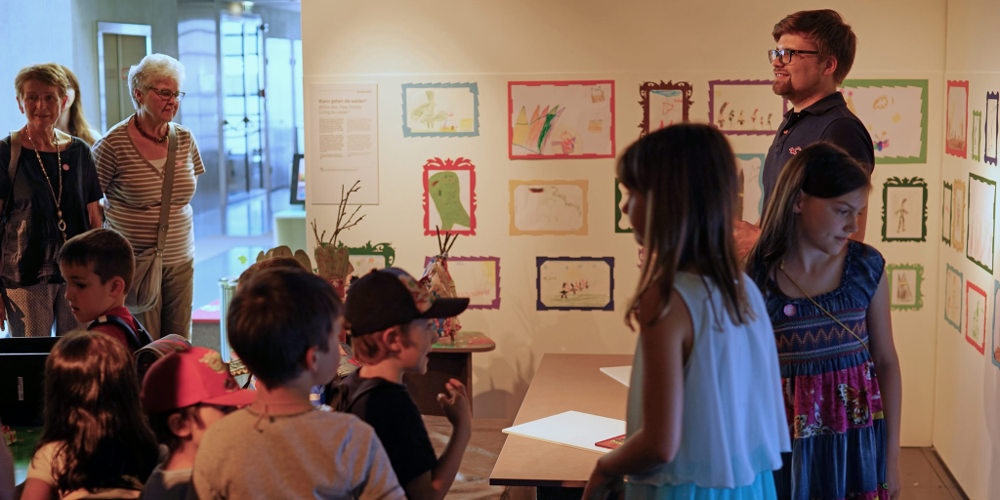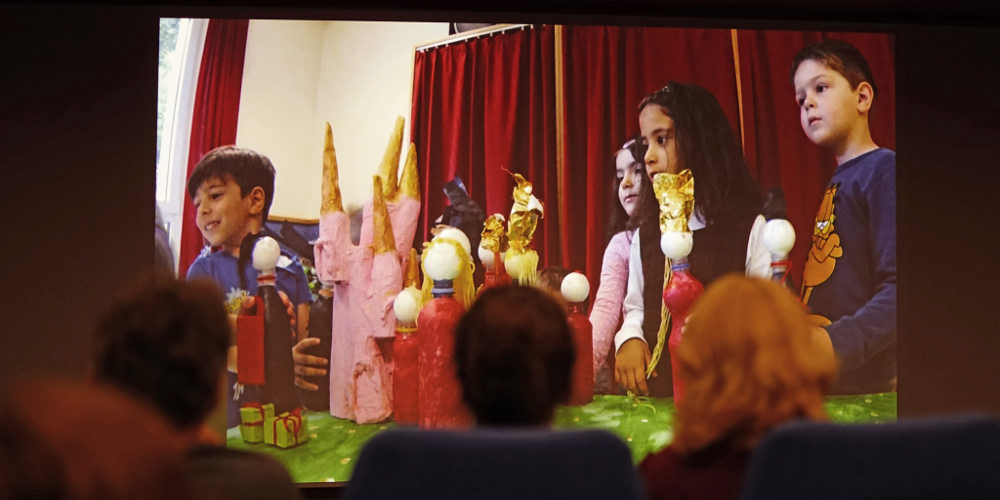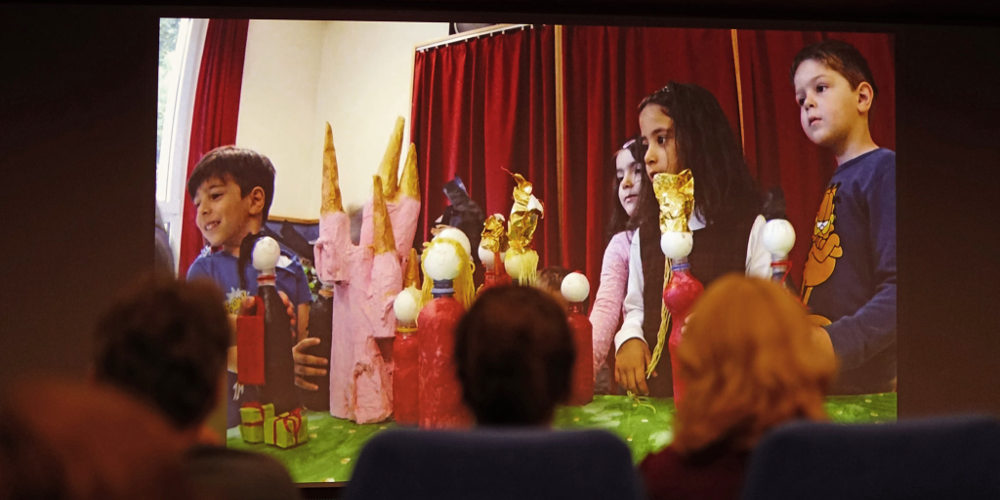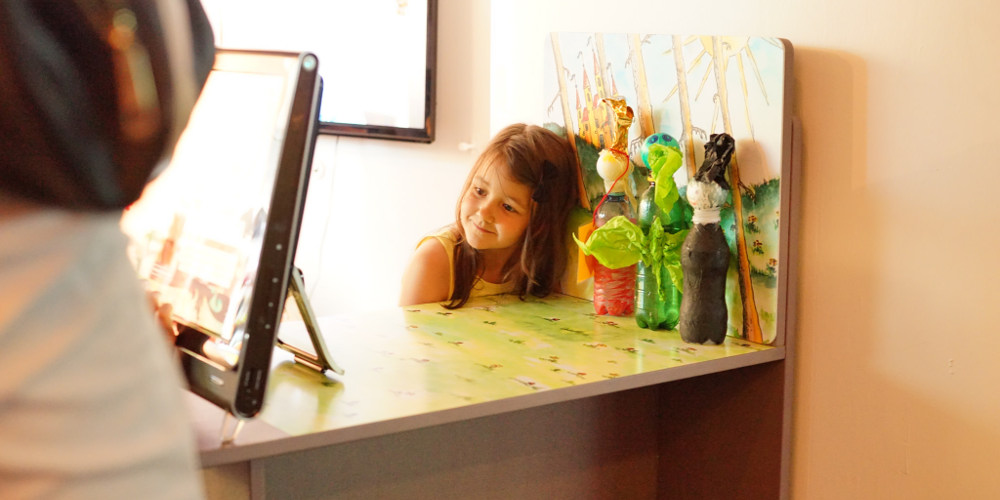“Patchwork family” is a relatively new term to describe a familial form that’s actually been around for quite a while. Whereas it used to usually be the remarriage of a widowed spouse that gave rise to a so-called stepfamily, the modern patchwork family comes about most often in the wake of a divorce. In Austria these days, nearly half of all marriages end in divorce, and to this number can be added breakups of unmarried couples with children. When single parents enter into new partnerships, they create so-called patchwork families.
A project entitled Linz Picture Book Kindergartens gave kindergarten classes the opportunity to select their favorite book from among 12 choices and then apply an artistic design to the story. The kids attending the Kindergarten of the Future this year selected Ute Krause’s “Wann gehen die wieder?” [When Are They Finally Going to Leave?] and thus dealt with issues having to do with patchwork families. The youngsters made drawings of the characters and settings, and acted out the story of the robber-dragon-princess patchwork family in a video. Now, videos of the kids at play as well as at work are being screened in the Ars Electronica Center. Visitors can also craft likenesses of their own family members and create a family portrait they can take home with them.
We recently chatted with Elisabeth Pils, director of the Kindergarten of the Future, about how kindergarten kids deal with the matter of the patchwork family and how the kindergarten can help them come to terms with this new situation.

The kindergarten teachers of the Kindergarten of the Future (middle: Elisabeth Pils)
The organizational structure of the Kindergarten of the Future differs somewhat from that of a “normal” kindergarten since kids are grouped by interest instead of by age. What exactly does that mean?
Elisabeth Pils: We work according to the so-called co-construction approach. Our children are researchers who explore their environment. Kids learn from their surroundings, from us teachers, as well as from other youngsters. We hold learning workshops that are divided up by theme, and the kids choose which room they’re going to be in according to their current needs and which project they want to participate in. For the children who are spending their last year in kindergarten, we offer special sessions in the respective learning workshops.
What are the advantages of this structure?
Elisabeth Pils: In a conventional kindergarten, kids age 3 to 6 are usually put together in a single room, but in our facility, the kids aren’t assigned to one particular room. For me, when the kids have to do everything in one room, that means something like being incarcerated. With us, they have many more possibilities and the children’s various talents can be nurtured. They can also withdraw to what might be called a retreat. When a child is in kindergarten from 7 AM to 4 PM, he/she occasionally needs a bit of serenity in a quiet location where there aren’t a lot of other kids around. The important thing here is that the child can decide when to go on a brief retreat, so our children aren’t forced to take a nap at a specified time of day.

Why did the Kindergarten of the Future agree to participate in Linz Picture Book Kindergartens? How do the children benefit from this?
Elisabeth Pils: The area of emphasis in all Linz Picture Book Kindergartens is fostering language skills among children of kindergarten age. Picture books are conducive to telling stories and stimulate hands-on creativity, which is what makes them so important. That’s why we participate every year. Plus, so we can get the word out in public about how important pedagogical work is in kindergarten and all the valuable things we do here.
In conjunction with Linz Picture Book Kindergartens, the kids had 12 books to choose from. They picked their favorite and then created works of art to illustrate it. How was the decision made?
Elisabeth Pils: The children selected their favorite book in democratic fashion. After we went through the 12 picture books with them, we presented them, one after the other. Then they each cast their ballots and the one that received the most votes was the winner. And that was “When Are They Finally Going to Leave?”

Is this also part of the concept of the Kindergarten of the Future, that the kids have a say in what happens?
Elisabeth Pils: Yes, we make every effort to see to it that the children play an active role in planning and organizing their activities. We gladly accept suggestions from children, consider whether their ideas are doable, and then we seek out solutions jointly. And at regular intervals, certain rules are called into question—by us as well as by the children—and repeatedly discussed.
“When Are They Finally Going to Leave?”is a book about life in a patchwork family and how kids deal with this situation. Why do you think your kids chose this book? How do kids of kindergarten age who are personally confronted with situation deal with it?
Elisabeth Pils: The patchwork family is currently a very topical issue and several children in our kindergarten live in patchwork families. Maybe that’s why they chose this book. Talking about this subject is something that some children, even youngsters in kindergarten, taken completely for granted. Then again, others are more reserved. We’re pleased when parents tell us that they’re going to be splitting up so we can start working with the child in an appropriate way. But it always depends on whether the child wants to talk about it or not. Sometimes role-playing is the best approach to this set of issues. What we don’t do is interrogate the child; instead, we wait until he or she comes to us with questions and then we’re glad to be able to help.

How can the kindergarten support kids living in patchwork families?
Elisabeth Pils: The most important things are listening when children talk about their worries, problems and fears, and attempting to answer all their questions. Children can come to terms with something like this by means of role-playing, just as we’ve done in recreating the narrative of this book.

How did these kindergarten kids artistically interpret the book?
Elisabeth Pils: Once the children had selected the book, we as a group discussed what we could do with it. Two years ago, we used a book as the basis of an animated film, which is why we wanted to do something different this time around. So we got the idea of producing it as a table puppet play that we could subsequently film. Then we gave some thought to which materials we could use for the figures and sets so that the children could create as much as possible on their own. That’s why the figures are made out of PET bottles that the kids decorated themselves, and they used cardboard cartons in very imaginative ways to produce the sets and scenery in which the plot takes place.
I think it’s very important that the children gain a sense of self-reliance from this experience. In addition to the puppetry, the children also drew the characters in the book. One of our girls was supposed to draw a dragon but she claimed that she couldn’t do it. Nevertheless, after I encouraged her and told her I was absolutely convinced she could manage this, she dared to go ahead and just paint, and in the end she was very proud of the results. When I ask children whether they can help me or if they can do something or other, their first reaction is often to say: “I can’t do that!” But this is another big part of our concept: strengthening the children’s sense of competence, self-reliance and willingness to expand their limits. That’s one of the utmost principles of our pedagogical work: “Help me to do it on my own!”

Please visit the “Wann gehen die wieder?” exhibition on the 1st Upper Level of the Ars Electronica Center during regular opening hours.
In the summer holidays the Ars Electronica Center offers a variety of workshops for 6 to 14 year olds. Browse through the workshops and sign up today: https://ars.electronica.art/center/programm/ferienprogramm/
